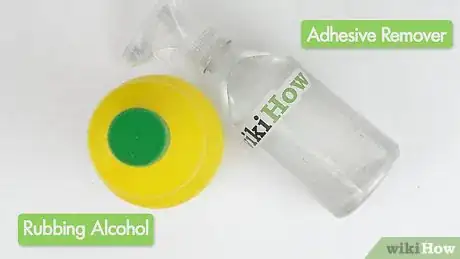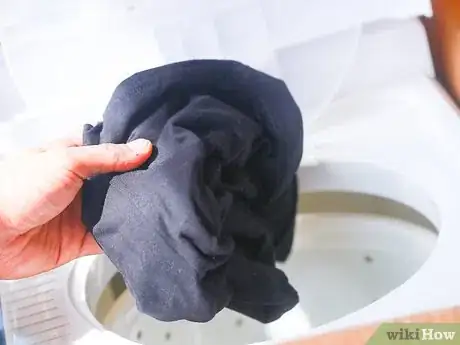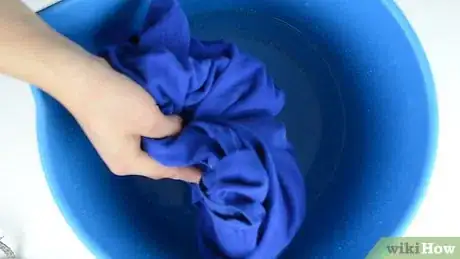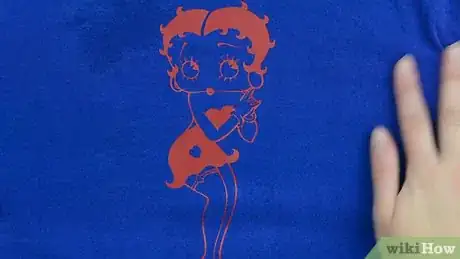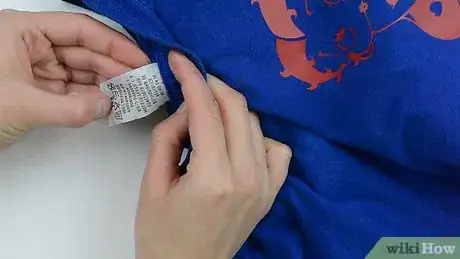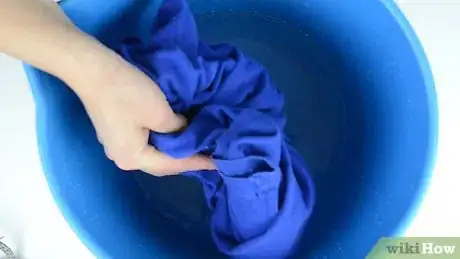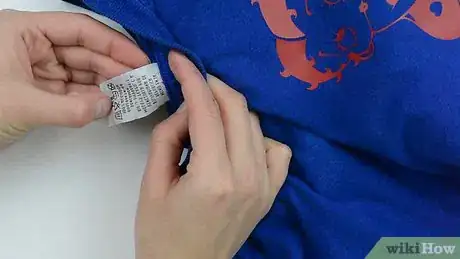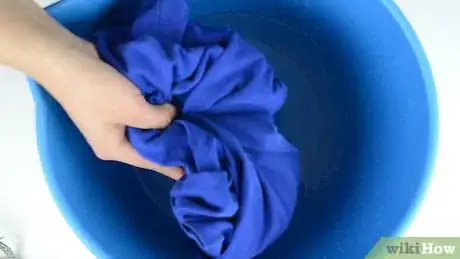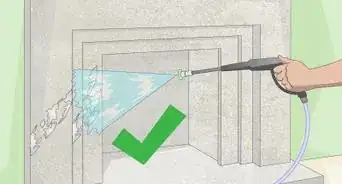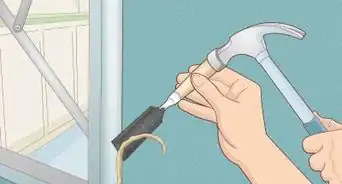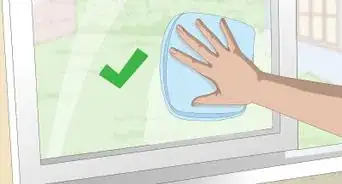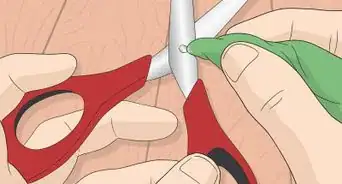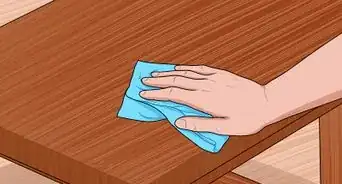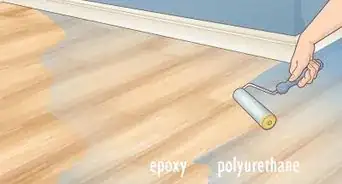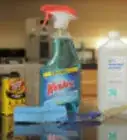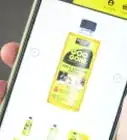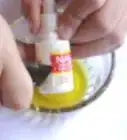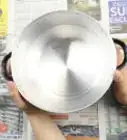This article was co-authored by Rani Gorgis. Rani Gorgis is a Laundry and Cleaning Specialist and the Owner of Park Blvd Laundry & Dry Cleaners in San Diego, California. With several years of experience in the laundry and cleaning industry, Rani specializes in dry cleaning, wash-n-fold, shirt laundry, and servicing smoke-damaged clothes. He holds a BS in Accounting and a CPA certification.
wikiHow marks an article as reader-approved once it receives enough positive feedback. In this case, several readers have written to tell us that this article was helpful to them, earning it our reader-approved status.
This article has been viewed 1,482,251 times.
Iron-on transfers can be a great way to express your own personal style, and make a cool addition to many different items of clothing. However, you may decide after having an iron-on transfer for a while that you are tired of looking at it. Unfortunately, most iron-on transfers are permanent. However, you can try to remove the transfer using one or more of the approaches in the steps below.
Things You Should Know
- Spray the back of the patch with a solvent like acetone, rubbing alcohol, or Goo Gone. Stretch the fabric and peel or scratch the patch off, then wash.
- Alternatively, loosen the patch with heat from a hair dryer or steam from a hot, wet towel. Scrape the patch off with a sharp knife and wipe away any residue.
- If it’s still stuck, grab an iron on high heat and place a sheet of parchment paper over the patch. Iron it with quick strokes to melt the adhesive.
Steps
Using Chemical Solvents to Remove Transfer
-
1Purchase a chemical solvent made for removing lettering. There are solvents made for this specific purpose,[1] but you could try household solvents such as nail polish remover, rubbing alcohol, or an adhesive remover such as Goo Gone.
-
2Place your garment in the dryer. Putting the item in the dryer on high heat for a few minutes will heat the adhesive and possibly loosen it a little.[2]Advertisement
-
3Turn your garment inside-out. The transfer should be on the inside. You should locate the area of the transfer and place your garment so that the inside of the shirt with the transfer behind it is facing up (so that if you could see through the shirt, you would see the back side of the transfer).[3]
-
4Test an area of the garment. Before applying solvent all over the garment, test a discreet area to be sure that the chemical does not damage the garment.
-
5Saturate the garment with the solvent. Apply the solvent liberally to the areas of the garment that have the transfer on the other side. [4] The idea is that the solvent will soak through the fabric and loosen the adhesive between the fabric and the transfer.
-
6Stretch the fabric. Stretching and wiggling the fabric will help the solvent soak through the fabric and penetrate the adhesive. After stretching, you may want to apply more solvent. [5]
-
7Peel the transfer away. If the solvent has worked, you should be able to peel the transfer off of the garment. You may need to encourage the transfer to peel off by using a knife to scrape it up or by applying additional heat with a hair dryer.
-
8Remove any glue residue. After the transfer has been removed, you may find some adhesive left over. You can try removing it with rubbing alcohol or an adhesive remover such as Goo Gone. Be sure to check a discreet corner of the material for reaction before using any chemical on the fabric.
-
9Wash the garment by itself. Wash the garment alone, either by hand or in the washing machine. Washing it with other garments may cause the solvent to damage other items of clothing. Be sure to wash the garment well, using extra detergent, before wearing to avoid skin contact with the solvent.
Using Heat and Steam to Remove Transfer
-
1Place the garment on a flat surface. An ironing board or tabletop covered with a towel would work. Be sure the surface that you are using is not sensitive to heat.
-
2Put a towel inside the shirt. Placing a small towel or rag inside the shirt may help prevent any damage to the other side of your garment. If the towel is making your work surface difficult because it is too soft, try a piece of cardboard or very thin plywood instead.
-
3Check the garment care instructions. Heating the garment beyond recommended settings may cause damage to the material. Some materials, such as polyester, may actually melt if overheated.
-
4Use a hairdryer to heat the transfer. A hairdryer on its hottest setting, held very close to the letters, may heat the adhesive on the back of the transfer enough for it to become malleable and be removed.[6]
-
5Use steam to heat the transfer. Alternately, you can use steam to treat the transfer. Place a wet towel over the transfer and put a very hot iron on top of it. [7] The steam may heat the adhesive on the back of the transfer enough for it to become malleable and be removed.
-
6Use a sharp knife to peel up the transfer. Once the transfer has loosened with the heat, scrape a sharp knife along the edge to pry up the iron-on transfer. [8] Once part of the transfer has been pried up, it should be easier to continue pulling up the transfer a little at a time.
-
7Continue heating areas of the transfer and removing the transfer. You may need to do one very small area of the transfer at a time to keep it very hot in order to keep scraping it away.
-
8Be patient. This method may take a long time. Put on some of your favorite music and challenge yourself to stick with it until it is all finished.
-
9Remove any glue residue. After the transfer has been removed, you may find some adhesive left over. You can try removing it with rubbing alcohol or an adhesive remover such as Goo Gone. Be sure to check a discreet corner of the material for reaction before using any chemical on the fabric.
-
10Wash the garment as usual. After you have removed the transfer and residue, launder the garment as you normally do. Be sure to do this if you used any kind of chemical to remove leftover residue, as chemicals may irritate or harm your skin.
Removing a Transfer With An Iron
-
1Place the garment on an ironing board. Be sure that the transfer is facing up, and lay the garment out completely flat. If you do not have an ironing board, you can lay a towel across a hard surface such as a table, counter, washing machine, or dryer.
-
2Put a towel inside the shirt. Placing a small towel or rag inside the shirt may help prevent any damage to the other side of your garment. If the towel is making your work surface difficult because it is too soft, try a piece of cardboard or very thin plywood instead.
-
3Check the garment care instructions. Heating the garment beyond recommended settings may cause damage to the material. Some materials, such as polyester, may actually melt if overheated. This method involves direct heat and runs a higher risk of damaging the garment than other methods.
-
4Heat your iron. The iron should be as hot as possible. This may mean that the iron will be hotter than the care instructions for the garment allow. If you are worried about damaging the garment, you may want to try a different method. You could try starting with a medium heat and slowly turning the iron hotter to find the right temperature that will remove the transfer but not damage the garment.
-
5Lay parchment paper over vinyl letters. If the transfer is made of vinyl, place parchment paper over the letters and iron directly on the parchment paper. The vinyl transfer will essentially melt and stick to the parchment paper, and you can peel the letters away from the shirt by removing the parchment paper. This only works with vinyl transfers.
-
6Apply the iron to a corner of the transfer. The heat from the iron should essentially melt the transfer away. [9] Start with a corner and work your way across the transfer.
-
7Use quick strokes of the iron to remove the transfer. Once a corner has come off, make quick movements with your iron in the direction of the transfer. [10] It should continue to peel up and possibly burn off as you go.
-
8Continue until the transfer is gone. Repeat the strokes of the iron directly on the transfer until it has been completely removed. If you garment appears to be getting damaged, you may want to turn down the heat a bit.
-
9Remove any glue residue. After the transfer has been removed, you may find some adhesive left over. You can try removing it with rubbing alcohol or an adhesive remover such as Goo Gone. Be sure to check a discreet corner of the material for reaction before using any chemical on the fabric.
-
10Wash the garment as usual. After you have removed the transfer and residue, launder the garment as you normally do. Be sure to do this if you used any kind of chemical to remove leftover residue, as chemicals may irritate or harm your skin.
Community Q&A
-
QuestionHow do you remove iron-on transfer glue from fabric?
 wikiHow Staff EditorThis answer was written by one of our trained team of researchers who validated it for accuracy and comprehensiveness.
wikiHow Staff EditorThis answer was written by one of our trained team of researchers who validated it for accuracy and comprehensiveness.
Staff Answer wikiHow Staff EditorStaff AnswerIf there’s still adhesive sticking to the fabric after taking off the decal, you might be able to remove it by blotting the area with a cloth or cotton ball soaked in acetone (nail polish remover). Next, blot the area with a clean cloth to try to pick up the glue. If you’re worried about the acetone staining or damaging the fabric, an alternative method is to put the garment in the freezer to freeze the glue, then scrape it off with a spoon or a dull knife while it’s still brittle and hard.
wikiHow Staff EditorStaff AnswerIf there’s still adhesive sticking to the fabric after taking off the decal, you might be able to remove it by blotting the area with a cloth or cotton ball soaked in acetone (nail polish remover). Next, blot the area with a clean cloth to try to pick up the glue. If you’re worried about the acetone staining or damaging the fabric, an alternative method is to put the garment in the freezer to freeze the glue, then scrape it off with a spoon or a dull knife while it’s still brittle and hard. -
QuestionIs there a way to remove iron-on transfer paper if it gets stuck to a shirt?
 wikiHow Staff EditorThis answer was written by one of our trained team of researchers who validated it for accuracy and comprehensiveness.
wikiHow Staff EditorThis answer was written by one of our trained team of researchers who validated it for accuracy and comprehensiveness.
Staff Answer wikiHow Staff EditorStaff AnswerIf paper gets stuck to the shirt, that usually means that the transfer didn’t completely take. Try laying the transfer back down and pressing it again. If you notice a few pieces of paper still sticking, spritz the shirt lightly with water, lay a sheet of Teflon over the transfer, and press it again. The remaining fragments should come off.
wikiHow Staff EditorStaff AnswerIf paper gets stuck to the shirt, that usually means that the transfer didn’t completely take. Try laying the transfer back down and pressing it again. If you notice a few pieces of paper still sticking, spritz the shirt lightly with water, lay a sheet of Teflon over the transfer, and press it again. The remaining fragments should come off. -
QuestionHow do you take off an iron-on patch?
 wikiHow Staff EditorThis answer was written by one of our trained team of researchers who validated it for accuracy and comprehensiveness.
wikiHow Staff EditorThis answer was written by one of our trained team of researchers who validated it for accuracy and comprehensiveness.
Staff Answer wikiHow Staff EditorStaff AnswerIron-on patches are applied with heat-activated glue. Put a piece of cloth or parchment paper over the patch and run your iron over it to heat it up and soften the glue again, then carefully peel off the patch. You can then use a fabric-safe adhesive remover to take off any glue residue.
wikiHow Staff EditorStaff AnswerIron-on patches are applied with heat-activated glue. Put a piece of cloth or parchment paper over the patch and run your iron over it to heat it up and soften the glue again, then carefully peel off the patch. You can then use a fabric-safe adhesive remover to take off any glue residue.
References
- ↑ http://www.stahls.com/lettering-remover-solvent
- ↑ Rani Gorgis. Laundry & Cleaning Specialist. Expert Interview. 7 April 2021.
- ↑ http://www.stahls.com/lettering-remover-solvent
- ↑ http://www.stahls.com/lettering-remover-solvent
- ↑ http://www.stahls.com/lettering-remover-solvent
- ↑ https://www.youtube.com/watch?v=9z4aemfDdAc
- ↑ https://www.youtube.com/watch?v=9z4aemfDdAc
- ↑ https://www.youtube.com/watch?v=9z4aemfDdAc
- ↑ https://www.youtube.com/watch?v=9z4aemfDdAc
About This Article
You can often remove iron-on transfers from clothes with simple household solvents. Choose a solvent such as rubbing alcohol, nail polish remover, or an adhesive remover like Goo Gone. Put your garment in the dryer on high heat for a few minutes to soften the adhesives in the transfer. Then, turn the item inside out so the transfer is on the inside. Spray the back of the garment where the transfer is located with your solvent until the cloth is saturated. Next, stretch and wiggle the fabric with your hands to help the solvent soak in. Turn the clothing right-side out and peel the transfer off. You can also remove stubborn fragments by scraping them off with a knife. If there’s still any gooey residue left, scrub it away with a soft cloth soaked in your solvent. When you’re done, launder the garment by itself with a little extra detergent. For tips on getting rid of additional adhesive or using steam to remove an iron-on, read on!
